Understanding the Scottish rural economy: research paper
This report outlines the Scottish Government's understanding of the Scottish rural economy and presents economic and social data.
Defining the Rural Economy
There is not an agreed definition of the rural economy in Scotland, and often people use the term as a synonym for agriculture. In this paper, we take the approach that what matters in Scotland's rural economy is what is produced, built, delivered etc. in Rural Scotland and by people living there. As a result, we have looked across all sectors and employment categories to give as full a picture as possible of Scotland's rural economy today.
The first challenge when defining the rural economy, is to establish which areas of Scotland count as rural. Whilst this may seem straightforward, there are real challenges due to data availability, and so for different questions different definitions need to be applied.
For social survey data there is a standardised approach to defining whether respondents or households are in urban Scotland, or varying degrees of rurality or more Remote Rural Scotland. Definitions for social survey data are updated using data from the National Records of Scotland on population and transport data on remoteness.
Currently, there is no equivalent standardised measurement approach for rural economy data as economic data such as Gross Value Added is only available at the local authority level and not at a disaggregate data zone level. So while for social survey data we can distinguish areas in Scotland at a much smaller level, for economic data we need to define which local authority is considered rural or urban. In previous RESAS work we have made use of the Randall definition of Rural Scottish local authorities, first developed in 1985. The Randall definition is binary and only distinguishes between rural and urban. It is solely based on population density (see table below). As a result of using the Randall definition it is hard to get a nuanced picture of the variety within rural Scotland, and the two-fold approach is seen as being a too simplistic instrument for analysis.
In order to get a more holistic and detailed picture of rural Scotland, this paper applies a new classification of the rural economy taking more factors into account that are considered rural, both in the literature and in existing classifications. As a result of a statistical analysis (see methodological annex), the new RESAS Classification clusters local authorities according to their level of rurality and establishes four different groups, which are labelled as "Larger Cities", "Urban with Substantial Rural areas", "Mainly Rural" and "Islands and Remote" (see figure 1 below).
Figure 1: RESAS Classification of the rural economy
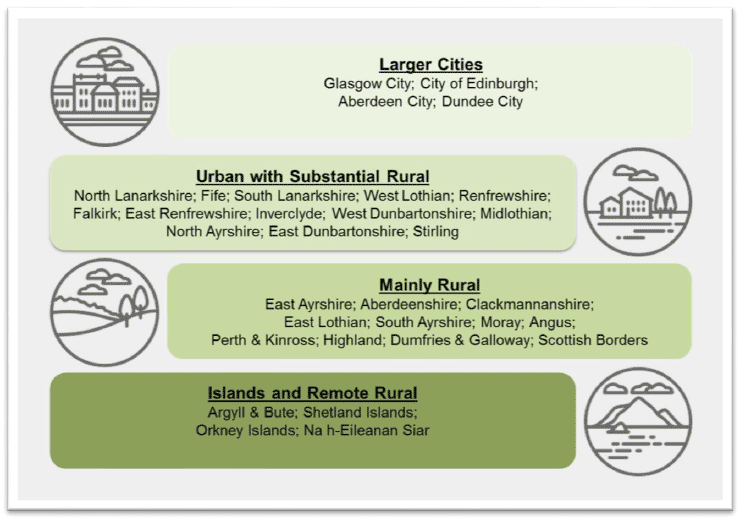
This new classification of the rural economy does not replace the main Scottish Government Urban/Rural classification which should be used for all non-economic data. The classification is based on a quantitative analysis that allows us to identify key drivers of rurality such as the relative share of population in pensionable age and broadband connectivity. An index was calculated that ranks local authorities according to their degree of rurality. In a second step, these local authorities are then divided into four groups according to their share of population living in urban settlements.
Because this index for the RESAS classification of the rural economy does not neatly follow the share of the urban population, some local authorities are classed differently than the share of their urban population would suggest. South Ayrshire and Angus for example have more than 50% of their population living in large urban and other urban areas and thus should be classed Urban with Substantial Rural. However, because according to their RESAS score they clearly are more rural than Stirling and other more urban areas, they are classed as Mainly Rural. While the island authorities and Argyll and Bute are classed as Islands and Remote Rural due to their RESAS score and the low share of urban population, Highland is classed as Mainly Rural despite the remoteness of large parts of the local authority. This is mainly due to Inverness. Dumfries and Galloway and Scottish Borders are also classed as Mainly Rural and not Island and Remote Rural due to their relatively lower share of population living in settlements under 10,000 and generally higher population density compared to the island authorities. These examples illustrate that the RESAS classification as all other Urban/Rural classifications is an aggregation of data and thus simplifies the heterogeneity of the Scottish rural economy. However, as it is based on wide range of data and quantitative analysis, the classification is a useful tool to describe the rural economy.
Table 1 Urban/ Rural classifications
| SG Main Urban Rural classification: |
The Randall Definition: |
The RESAS Classification: |
|---|---|---|
| According to the Scottish Government Urban/Rural classification, rural Scotland is defined as settlements with a population of less than 3,000. A settlement is defined to be a group of high density postcodes whose combined population rounds to 500 people or more. By analysing drive times to larger settlements, we can divide rural Scotland into Accessible Rural and Remote Rural. On the standard Urban/Rural classification, around 98% of Scotland's landmass and around 19% of its population are identified as rural. The classification allows for a range of analyses at differing levels, each of which makes it possible to talk in progressively more detail about the statistics for rural households. The data sourced from the Inter-Departmental Business Register for example use the Urban/Rural sixfold classification. These figures exclude self-employment and businesses that are not VAT registered. The Urban/Rural classification is also not applicable to economic data, as for example Gross Value Added figures are only provided at the local authority level and not at the data zone level. |
The Randall definition identifies rural local authorities with a population density below one person per hectare. As it is at local authority level it tends to over-state the rural population ( e.g. the populations of Stirling, Perth and Inverness are considered 'rural) and understate the rural area ( e.g. East Lothian and South Lanarkshire are considered 'urban'). According to the Randall definition of rurality, 89% of Scotland's landmass and 29% of its population is classified as rural (rebased 2017). However, as most economic data is only available at LA level, Randall still serves a useful purpose. [1] The definitions are included in the annex 2 to this paper. |
The RESAS definition groups the economies of local authorities according to their degree of rurality. Rurality is defined as a combination of various factors such as demographic and geographical data, broadband connectivity and access to services. Local authorities are divided into four groups and cut-off points have been chosen based on the local authorities' share of the population living in large urban or other urban areas. More than 90% of the population live in large urban areas in the most urban group - classed as 'Larger Cities'. This group is followed by 'Urban with Substantial Rural areas' where more than 50% of the population live in large and other urban areas. Less than 20% of the population live in urban and other urban areas in 'Islands and Remote areas' and the rest is defined as 'Mainly Rural'. |
Details of the areas covered by the three definitions are shown in the three maps below. Map one follows the SG Urban/Rural classification to data zones, the second map applies the Randall definition to local authorities and the third map uses the new RESAS Classification for local authorities.
Map One
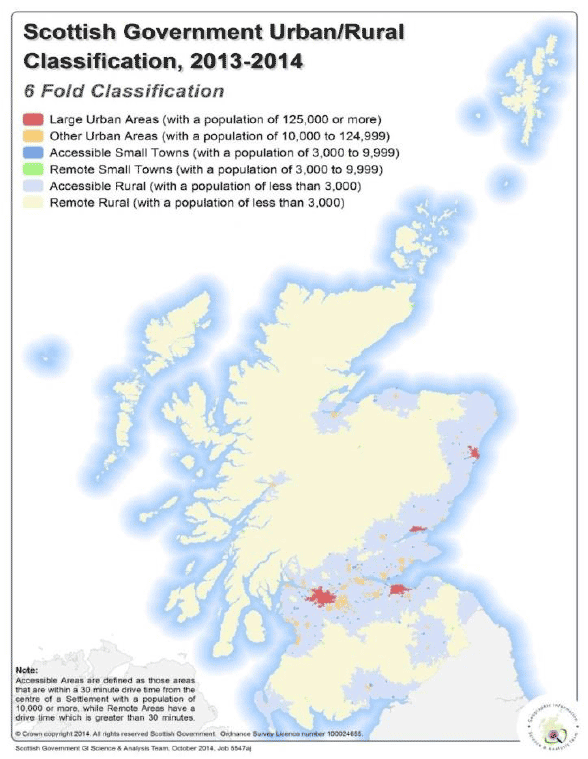
Map Two
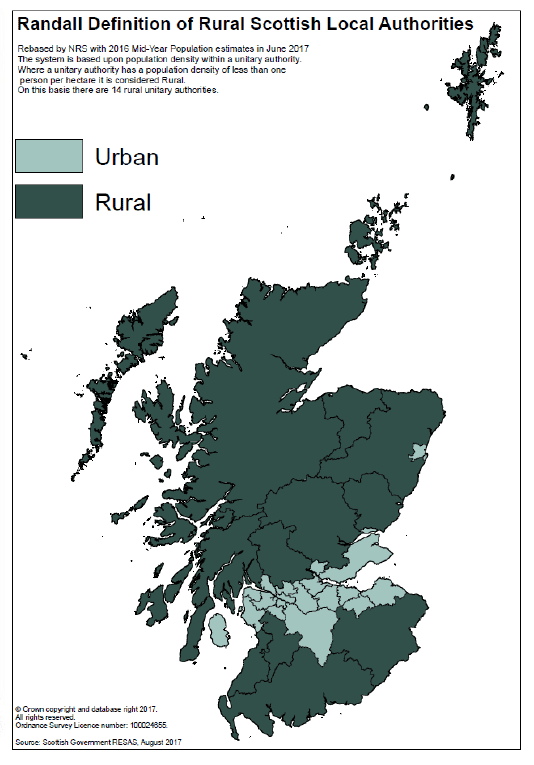
Map Three
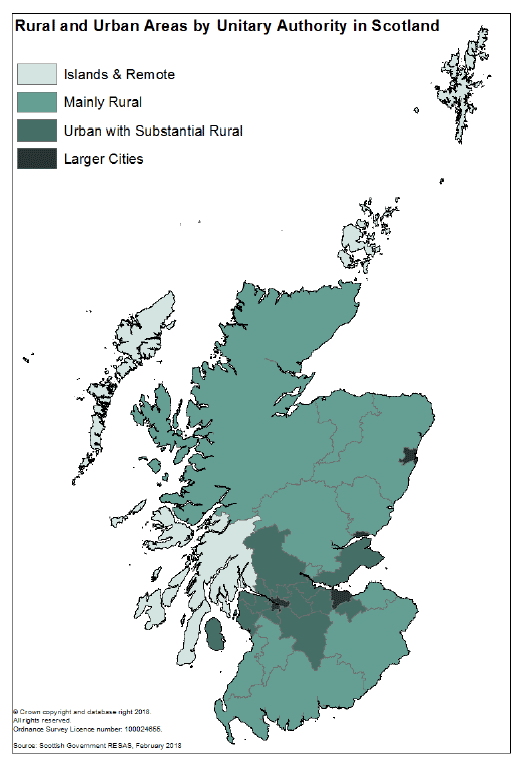
By using the new RESAS definition for the rural economy, it is now possible to look at rural Scotland from a more nuanced economic perspective. Table 2 lists the Gross Value Added for each of the main sectors in Scotland (for a breakdown of the industrial sectors see annex 4). Using the Standard Industrial Classification and applying the RESAS Classification, we can distinguish between Larger Cities [2] , Urban with Substantial Rural areas [3] , Mainly Rural [4] areas and Islands & Remote areas [5] . Recognising the difference between Mainly Rural and Islands & Remote areas, allows us to clearly identify the most productive sectors in terms of their GVA and identify variation within rural Scotland. Rural Scotland here describes both Mainly Rural areas and Islands and Remote areas. The relative share of each sector is illustrated in chart 1.
Comparing industry sectors in rural and urban Scotland
The focus of this paper is to understand the rural economy. In a first step, we therefore need to see to what extent the rural economy is different to urban Scotland. Table 2 below lists the GVA contributions for each sectors in 2015 using the RESAS classification. We can see that both in urban Scotland (this includes Larger Cities and Urban with Substantial Rural) and rural Scotland (Mainly Rural and Islands and Remote) the two largest sector of the economy in terms of their Gross Value Added are 'Public Administration; Education; Health' (23% of the overall Scottish economy) and 'Distribution; Transport; Accommodation and Food' (19% of the overall Scottish economy). Together it is estimated that in 2015 the two largest sectors 'Public administration; education; health' and 'Distribution; transport; accommodation and food' represent nearly half of the rural economy, even though their share varies across areas. In Mainly Rural areas, 42% of the GVA stems from the two largest sectors, while in Islands and Remote areas this share rises to 48%. In Larger Cities this share drops to 39% due to the relatively lower significance of 'Distribution; transport; accommodation and food', but reaches 43% in Urban with Substantial Rural areas.
While some sectors such as 'Other services and household activities' (4% of the overall Scottish GVA) and 'Mining, Quarrying, Utilities' (5% of the Scottish GVA) are similarly important to urban and rural areas, some sectors' relative share varies. 'Agriculture, Fishing and Forestry' for example accounts for 1% of the Scottish average, but is relatively more relevant to rural areas. However, even in rural areas the sector only accounts for 3% of the GVA in Mainly Rural and 4% of the GVA in Islands and Remote Rural areas. Unsurprisingly, 'Finance' is relatively more important to Larger Cities (13%) than to Mainly Rural (2%) and Islands and Remote Rural (1%). 'Business Services' (10% of the Scottish GVA) is bigger in Larger Cities (13%) than in Mainly Rural (9%) and Islands and Remote Rural Scotland (7%).
There are a number of data challenges which means there can be problems in providing a robust analysis. For example, there are challenges in allocation of business, such as around head office locations, but there is not a clear way to simplify that for publication, and it is not clear if this has a specific urban/ rural effect.
To summarize, data on GVA in 2015 shows how the Scottish rural economy is different from the urban economy. The following section now examines differences within the rural economy.
Table 2: Rural and Urban GVA by Sector 2015
| Industry Sector | Larger Cities GVA £m | Urban with Substantial Rural GVA £m | Mainly Rural GVA £m | Islands and Remote GVA £m | Total GVA £m | Larger Cities GVA % | Urban with Substantial Rural GVA % | Mainly Rural GVA % | Islands and Remote GVA % | Total |
|---|---|---|---|---|---|---|---|---|---|---|
| Agriculture, Fish and Forestry | 124 | 365 | 998 | 120 | 1,607 | 0.2% | 1% | 3% | 4% | 1% |
| Mining, Quarrying, Utilities | 3,153 | 1,759 | 1807 | 225 | 6,944 | 6% | 4% | 6% | 7% | 5% |
| Manufacturing | 3,375 | 6,028 | 4,600 | 259 | 14,262 | 6% | 15% | 15% | 8% | 11% |
| Construction | 2,144 | 3,428 | 2,336 | 284 | 8,192 | 4% | 8% | 7% | 9% | 6% |
| Distribution; transport; accommodation and food | 8,567 | 8,194 | 6,523 | 699 | 23,983 | 16% | 20% | 21% | 21% | 19% |
| Information and Communications | 2,907 | 1,294 | 491 | 67 | 4,759 | 6% | 3% | 2% | 2% | 4% |
| Finance | 6,618 | 1,212 | 484 | 25 | 8,339 | 13% | 3% | 2% | 1% | 7% |
| Real Estate | 4,638 | 4008 | 3,745 | 366 | 12,757 | 9% | 10% | 12% | 11% | 10% |
| Business Services | 6,952 | 3185 | 2,745 | 237 | 13,119 | 13% | 8% | 9% | 7% | 10% |
| Public administration; education; health | 1,1875 | 9,456 | 6,433 | 872 | 28,636 | 23% | 23% | 21% | 27% | 23% |
| Other services and household activities | 1,767 | 1,617 | 1,166 | 118 | 4,668 | 3% | 4% | 4% | 4% | 4% |
| Total GVA | 52,120 | 40,546 | 31,328 | 3,272 | 127,266 | 100% | 100% | 100% | 100% | 100% |
Source: ONS local authority level GVA Statistics, as at August 2017 (Using Scottish Government RESAS Classification 2018)
Chart 1: The three largest and smallest industry sectors in terms of GVA share in Mainly Rural and Islands and Remote Rural Scotland, 2015
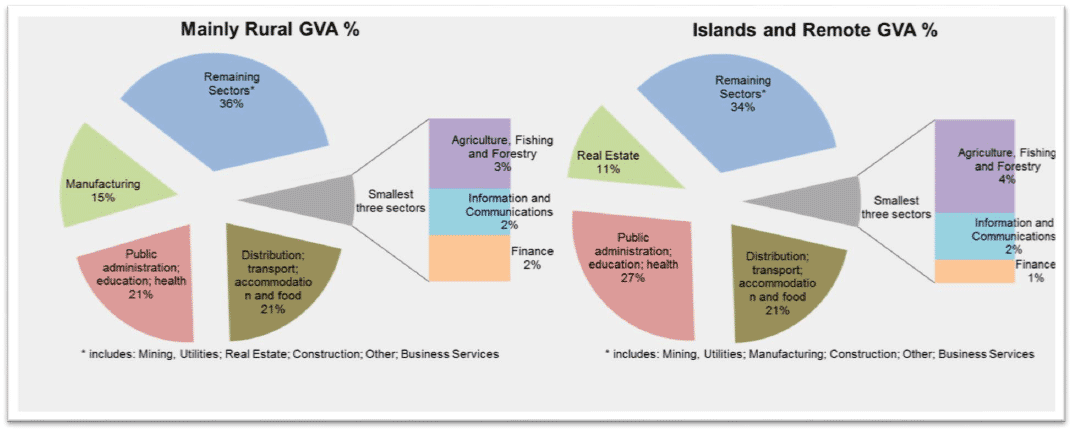
Source: ONS local authority level GVA Statistics, as at August 2017 (Using Scottish Government RESAS Classification 2018)
The largest and smallest sectors in rural Scotland
To understand the Scottish rural economy, chart 1 above illustrates the three largest and three smallest sectors of the economy in Mainly Rural and Islands and Remote Rural Scotland in 2015.
Unsurprisingly, we see that the two largest sectors are 'Distribution; Transport; Accommodation and Food' and 'Public Administration, Education and Health'. However, while the former sector accounts for 21% in both areas, the latter is relatively more important to Islands and Remote areas as 27% of the GVA in the areas stem from and 'Public Administration, Education and Health', but only 21% of the GVA in Mainly Rural areas.
Additionally, we see that while the third largest sector in Mainly Rural areas is Manufacturing (15% of the area GVA), it only accounts for 8% of the GVA in Islands and Remote. Here, Real Estate is the third largest sector (11% of the GVA). It needs to be highlighted that Real Estate accounts for 12% in Mainly Rural Scotland, which makes it the fourth largest sector.
The three smallest sectors in 2015 account for around 7% of rural economies. 'Agriculture, Fishing and Forestry' generates 3% of the GVA in Mainly Rural Scotland and 4% of the GVA in the Islands and Remote areas. The Scottish average is 1.3%. 'Information and Communications' accounts for 2% in both areas and Finance for 2% in Mainly Rural and 1% in Islands and Remote.
Because the RESAS classification aggregates data, it does not fully capture the heterogeneity of rural Scotland. Chart 2 illustrates the three largest sectors for each rural local authority. Overall, we see that as expected Distribution and Public Administration are amongst the three largest sectors in every local authority. Manufacturing is amongst the three largest sectors in Aberdeenshire (18% of local GVA), Angus (20%), Clackmannanshire (20%), Dumfries and Galloway (15%), East Ayrshire (15%), East Lothian (15%) Highland (12%), Moray (27%) and South Ayrshire (18%). Construction contributes substantially to the economy in Orkney Islands (11%) and Shetland Islands (11%), whereas 'Real Estate' accounts for 15% of the economy in Scottish Borders, 12% in Na h-Eileanan Siar and 13% in Argyll and Bute. 'Business Services' is the third largest sector in Aberdeenshire (15%) and 16% of the GVA in Perth and Kinross stems from 'Mining, Quarrying and Utilities'.
Chart 2: Three largest sectors in each local authority 2015 (% of LA GVA in brackets)
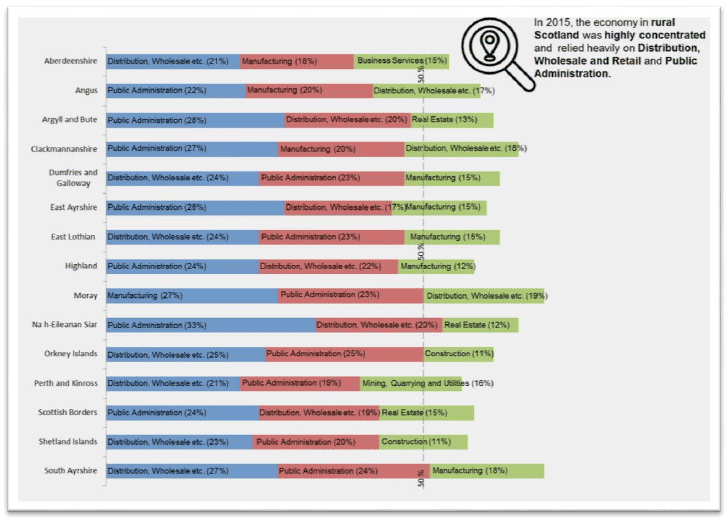
Source: ONS local authority level GVA Statistics, as at August 2017
The question remains which local authorities contribute the most to the three strongest and smallest sectors of the Scottish economy. Chart 3 below shows which local authority contributed the greatest proportions of sectorial GVA in the Rural economy across Scotland:
Chart 3: Largest contributions to Sector by local authorities of rural economy, 2015
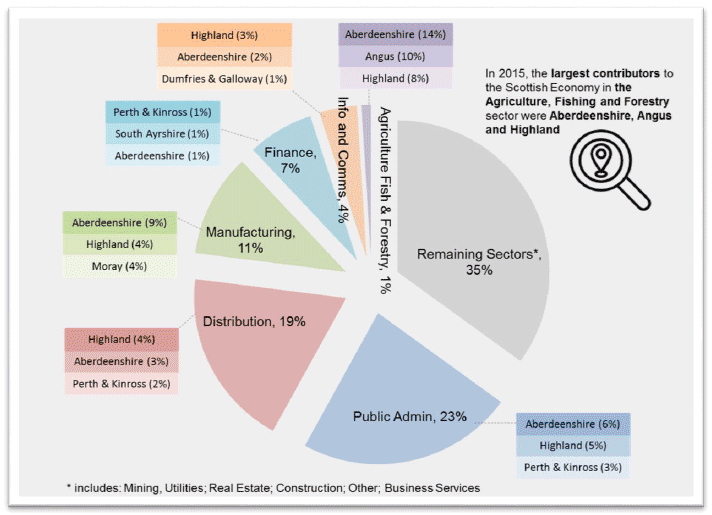
Source: ONS local authority level GVA Statistics, as at August 2017
The large and populous local authorities - Highland and Aberdeenshire - dominate the overall performance of Scotland's rural economies. Nevertheless, the two sectors with a relatively large rural contribution are 'Manufacturing' and 'Agriculture, Fishing and Forestry'. As discussed above, on Scottish average the Agriculture sector only accounts for about 1% of the GVA. A third of this stems from Aberdeenshire (14%), Angus (10%) and Highland (8%). Aberdeenshire and Highland - followed by Moray - also contribute substantially to the Manufacturing sectors. Aberdeenshire, Highland and Perth and Kinross dominate the rural economy's contribution to the Scottish economy in the Distribution, Public Administration and Information and Communications sectors. Perth and Kinross are the third biggest contributor amongst the rural local authorities to the Scottish Distribution and Public Administration sector with 2% of the Scottish Public Administration GVA and 3% of the Distribution GVA generated in the local authority.
The share of Agriculture, Fishing and Forestry for the rural economy
Scotland's rural economy is often equated with 'Agriculture, Fishing and Forestry'. However, with a total GVA of £1.6 billion (see table 2), 'Agriculture, Fishing and Forestry' only accounts for about 1% of the overall Scottish economy. Even in rural Scotland, the GVA share of the sector is marginal compared to other sectors of the economy. The largest contributor to the sector unsurprisingly is the rural economy. Of the £1.6 billion GVA nearly 70% is generated in Mainly Rural and Islands and Remote areas. Chart 4 below illustrates which local authorities contribute the most. In Angus and Orkney Islands, 8% of the overall GVA is based on 'Agriculture, Fishing and Forestry', followed by East Ayrshire with 6%. In contrast to this, the sector only accounts for 1% of the GVA in Clackmannanshire and South Ayrshire and 2% in Moray, Argyll and Bute and Perth and Kinross.
Chart 4: GVA share of Agriculture Fish & Forestry of rural local authorities, 2015
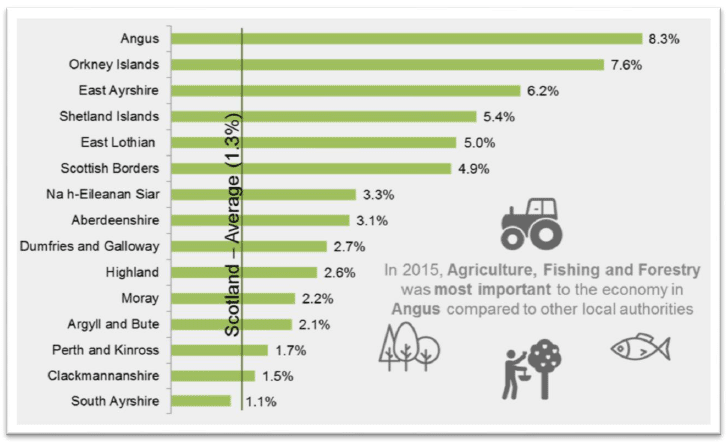
Source: ONS local authority level GVA Statistics, as at August 2017
Examining sectors independently from each other does not reflect how interconnected these are. This is for example the case for the sector 'Agriculture, Forestry and Fishing' that is - among others - linked with 'Accommodation and Food Services' and 'Sustainable Tourism' in particular. Chart 5 illustrates the importance of those two sectors to the rural economy. It needs to be highlighted here that in contrast to all previous graphs, the data does not stem from the ONS, but from the Inter-Departmental Business Register, produced via the Annual Business Survey. This data is structured differently so it is possible to dive deeper into individual sectors. It also allows us to more closely examine sectors that are connected with other industrial sectors which helps us to understand that sectors within the rural economy are not independent. However, data from the Inter-Departmental Business Register excludes the 'Finance' sector, parts of the agriculture and the public sector and also excludes non registered VAT businesses and self-employment. Hence, the data presented below does not reflect the GVA share of 'Sustainable tourism' and 'Accommodation and food services' of the overall economy, but is helpful in order to show the significance of not only agriculture, but also its surrounding sectors.
The agricultural sector contributes to food production, preservation of natural resources, employment and sustainable development of the rural territory. Besides agriculture, the two sectors tourism and food and accommodation are therefore affected by these areas.
Chart 5: Private Sector GVA share of 'Sustainable Tourism' and 'Accommodations and Food Services', 2015
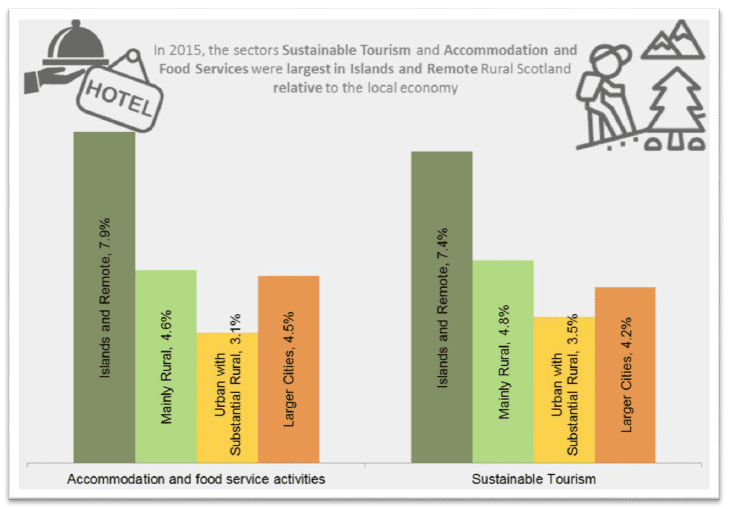
Source: Inter-Departmental Business Register, as at March 2016 (Using RESAS Classification 2018)
Following the RESAS Classification, data from the Annual Business Survey show that in 2015, accommodation and food services accounted for 7.9% of the GVA in Mainly Rural parts of Scotland (chart 5). This however only includes the private sectors and thus excludes the public sector, which, as we know from the previous section, accounts for a third of the GVA in Remote Rural Scotland. In rural areas of Scotland, accommodation and food services accounts for 4.6% to the economy which is similar to the cities. In Urban with Substantial Rural areas, the sector only contributes 3.1% to the economy. We can see similar trends for the sustainable tourism sector that is relatively more important for remote areas, followed by rural and urban areas.
Chart 6 shows the contributions of each rural local authority to 'Sustainable Tourism' in 2015 and the sector growth between 2009 and 2015.
Chart 6: 2015 GVA performance of Mainly Rural and Islands & Remote local authorities in the 'Sustainable Tourism' sector and changes between 2009 and 2015
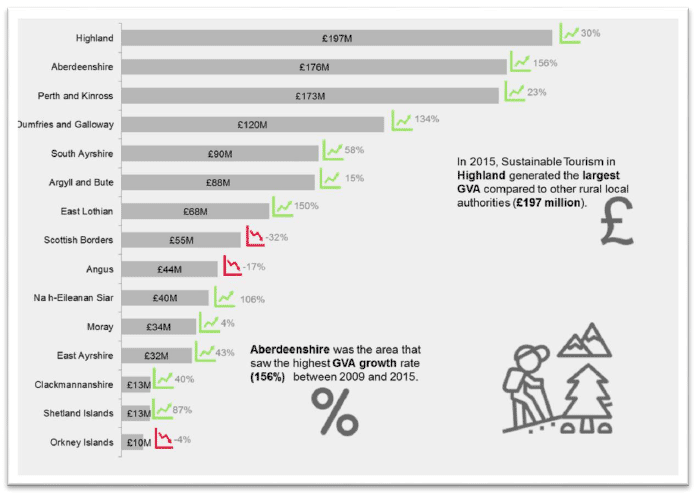
Source: Scottish Annual Business Statistics, as at August 2017 (using RESAS Classification, 2018)
In 2015, Highland, Aberdeenshire and Perth and Kinross dominated the 'Sustainable Tourism' sector in rural Scotland. Aberdeenshire has also seen the strongest relative growth as the sector's GVA has increased by 156%. In other words, Aberdeenshire's Sustainable Tourism has grown by 2.5 times between 2009 and 2015. There has been positive growth in all local authorities with the exception of Scottish Borders (down by 32%), Angus (-17%) and Orkney Islands (down by 4%).
Rural growth over time
This positive trend of a growing rural economy is also captured by chart 6 below that highlights the sectors that have grown strongest since 1997 in rural Scotland. The data used here stems from the ONS and includes all sectors and both the public and private sector. Scotland's Mainly Rural economy has nearly doubled between 1997 and 2015, from around £16.4 billion in 1997 to around £31.3 billion in 2015 (91% increase), while the economy in Islands and Remote areas has grown from £1.9 billion in 1997 to £3.3 billion in 2015 (74% increase). For a more detailed breakdown see table 1.2 and 1.3 in annex. Figure 2 below illustrates the sectors that have grown strongest and weakest between 1997 and 2015.
Figure 2: Relative GVA performance of strongest and weakest growth sectors in rural local authorities - between 1997 and 2015 (1997=100)
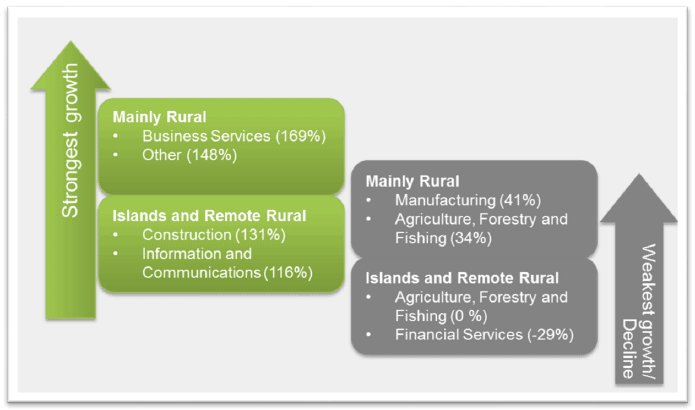
Source: Inter-Departmental Business Register, as at March 2016 (Using Scottish Government RESAS Classification 2018)
Here, seven sectors out of eleven are most striking: 'Business Services', 'Other Services and Household Activities', 'Information and Communications', 'Construction', 'Agriculture, Fishing and Forestry', 'Manufacturing' and 'Financial Services'. While the former four sectors have shown the strongest relative GVA growth between 1997 and 2015, the latter three have grown the least in relative terms.
'Business Services' accounts for 7% (Islands and Remote) to 9% (Mainly Rural) of the GVA in rural areas. This sector has grown by 169% since 1997 in Mainly Rural areas. 'Other services and household activities' accounting for 4% in both rural areas has grown by 148% in Mainly Rural areas. Therefore, these two sectors have shown the strongest GVA increase in the area. In Islands and Remote Rural areas, 'Information and Communications' and 'Construction' have grown strongest. 'Information and Communications Services; accounts for 2% in Island and Remote Rural areas and has more than doubled since 1997. 'Construction' accounts for 9% of the GVA in the area and has even increased by 131%.
On the other end of the scale, we find that 'Agriculture, Fishing and Forestry' - accounting for 3% (Mainly Rural) to 4% (Islands and Remote) - has shown the lowest GVA growth in rural Scotland with no growth at all in Islands and Remote and a growth of 34% in Mainly Rural Scotland.
'Manufacturing' - accounting for 15% of the GVA in Mainly Rural - has increased by 41% in Mainly Rural Scotland and lastly Financial Services (1% of the GVA in Islands and Remote) is the only sector in rural Scotland that has shrunk by 29% in Islands and Remote Rural Scotland.
Looking at the medium term trends for 2007-2015 (chart 7), covering the period of the credit crunch and recession, we can see that overall the Scottish economy has grown since 2007 with stark increases particularly after 2012. What is more, we see that the Mainly Rural economy has grown strongest (up by 24%), followed by the Islands and Remote Scotland and Larger Cities (both up by 19%) and Urban with Substantial Rural areas (up by 14 %). In real terms, the economy in Mainly Rural Scotland has grown from £25.3 billion to £31.3 billion, and in the Islands and Remote Rural areas from £2.7 billion to £3.3 billion (see tables 1.2 and 1.3 in annex 1).
Chart 7: GVA relative growth, by area, 2007 to 2015 (2007=100)
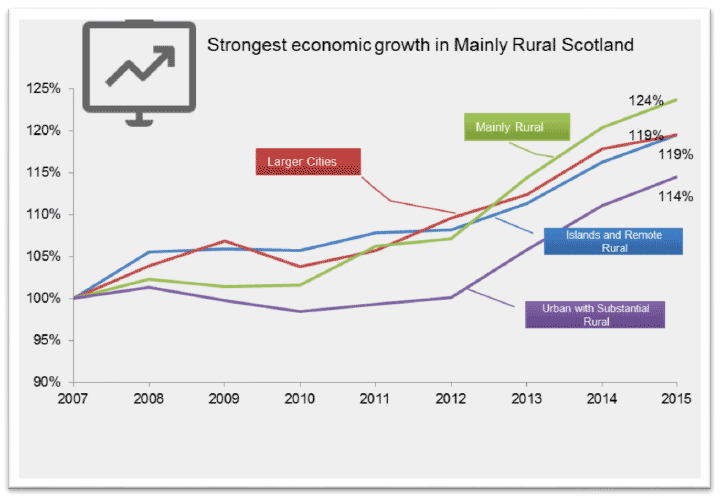
Source: Inter-Departmental Business Register, as at March 2016 (Using Scottish Government RESAS Classification 2018)
However, there are significant differences between rural and Remote Rural areas of Scotland and also between the sectors. For simplicity, chart 8 only shows the three sectors with the strongest growth and the three sectors with the weakest growth or even decline.
Overall, we can see that growth rates in more remote parts of Scotland (Islands and Remote) range wider than in mostly rural areas with the highest increase of more than 86 % in Manufacturing and 67% in Mining and Utilities. While the majority of sectors have grown at least slightly, we find that 'Financial Services' have diminished by more than half and 'Agriculture, Fishing and Forestry'; and 'Other Services' have also shrunk to 90% of their 2007 value. In more accessible Mainly Rural areas, the 'Financial Sector', 'Agriculture, Fishing and Forestry' and the 'Information and Communication' Sector have lower GVA than in 2007.
The rural economy has generally grown between 1997 and 2015 and has also significantly grown between 2007 and 2015. However, we need to clearly distinguish between Mainly Rural and the Islands and Remote parts of Scotland. This is because even though the overall rural economy has grown, growth rates and also the sectors affected vary crucially between areas. Agriculture, Fishing and Forestry in the most rural parts of Scotland has grown compared to 1997, but growth has slowed down in the 2000s. Compared to 2007, the sector has actually declined, most noticeably in the Islands and Remote parts of Scotland.
Chart 8: Relative GVA performance of the three fastest and weakest growing sectors - medium term picture, 2007 to 2015 (2007=100)

Source: Inter-Departmental Business Register, as at March 2016 (Using Scottish Government RESAS Classification, 2018)
Contact
There is a problem
Thanks for your feedback